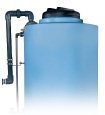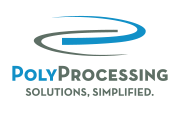Managing Hazardous Chemical Vapors in Storage Systems
Most chemicals emit vapors during storage, but certain substances present unique challenges that demand specialized solutions. Chemicals such as hydrochloric acid, acetic acid, and hydrofluoric acid generate particularly corrosive vapors that cannot be safely released into the environment. These aggressive fumes pose serious risks to storage infrastructure, surrounding equipment, and personnel safety.

The challenge with vapor-producing chemicals lies in finding the right balance: you can’t simply seal the storage vessel, because that can create dangerous pressure accumulation. At the same time, allowing these harmful vapors to escape is equally problematic.
At Poly Processing, we've engineered effective solutions to address these complex storage requirements while safeguarding your investment and workforce.
Addressing Vapor Management Challenges
Improper handling of chemical vapors can result in significant damage to both equipment and pose health risks to workers. Effective vapor control requires specialized engineering and thoughtful tank design. We've seen several examples where loose manway installations during maintenance allowed corrosive vapors to escape, which led to extensive corrosion damage to sensors, metal components, and surrounding infrastructure.
Given the destructive nature of these vapors and their potential for costly system damage, it’s essential to collaborate with Poly Processing early on during your project's planning phase. This proactive approach ensures that your property and personnel are fully protected from the outset.
Consider these two critical components for your upcoming chemical storage project:
Vapor Scrubbing Systems
.jpg?width=257&height=355&name=Poly%20Processing%20710%20Gallon%20Scrubber%20with%20Accessories%20(11).jpg) The most effective defense against harmful chemical vapors is a properly designed fume scrubbing system. This solution works by directing tank ventilation through a wet scrubber setup. Vapors travel through dedicated piping to a secondary containment vessel that’s equipped with a slotted PVC plenum. As vapors pass through this system, they bubble through a scrubbing solution that neutralizes both the harmful compounds and associated odors before releasing clean air through the top vent.
The most effective defense against harmful chemical vapors is a properly designed fume scrubbing system. This solution works by directing tank ventilation through a wet scrubber setup. Vapors travel through dedicated piping to a secondary containment vessel that’s equipped with a slotted PVC plenum. As vapors pass through this system, they bubble through a scrubbing solution that neutralizes both the harmful compounds and associated odors before releasing clean air through the top vent.
Poly Processing manufactures scrubber systems exclusively for our tank systems. Poly Processing’s PolyScrub™ is engineered to handle discharging vapor from chemical tanks during operation and filling. This innovative fume scrubber uses water to scrub harmful fumes before they evacuate the system. Each PolyScrub™ is designed by our application engineers to accommodate proper ACFM for a given system.
PolyScrub™ is available in two designs: a passive model where the operator checks and adjusts pH, or an actively monitored system that automates pH control for maximum performance.
Vapor-Sealed Access Points
.jpg?width=224&height=299&name=Poly%20Processing%20710%20Gallon%20Scrubber%20with%20Accessories%20(3).jpg) Our fume-tight manways and covers are specifically engineered for vapor-producing applications. These critical components feature polyethylene construction and specialized gaskets that create reliable seals. This design ensures complete vapor containment throughout the tank structure, with controlled release only through the designated scrubbing system.
Our fume-tight manways and covers are specifically engineered for vapor-producing applications. These critical components feature polyethylene construction and specialized gaskets that create reliable seals. This design ensures complete vapor containment throughout the tank structure, with controlled release only through the designated scrubbing system.
There are four main sizes for fume-tight lids that Poly Processing uses.
Our 7-inch and 10-inch fume-tight lids each thread on and are molded on smaller tanks. Our 17-inch and 24-inch lids are sealed with chemical bolts with molded plastic heads. The bolts are available in stainless steel, Alloy C-276 and titanium. Gasket materials available include EPDM, Viton®, Viton® GF, XLPE or Buna.
The 17-inch model is often used on 19-inch manways as well. A fume-tight manway cover is required for HCl applications.
Avoid Self-Installation Pitfalls
We strongly discourage any attempt to retrofit scrubbing systems onto existing tanks. While cost savings may seem appealing, improper installation typically creates more serious problems than it solves.
Common mistakes include inadequate venting capacity that creates dangerous back-pressure and accelerated tank failure. Another frequent error involves connecting multiple tanks to a single undersized scrubber, which can overwhelm the system and cause pressure backup throughout the connected vessels.
When planning storage for corrosive chemicals like hydrochloric or acetic acid, provide your Poly Processing representative with these essential details:
- Specific chemicals requiring storage
- Tank dimensions and capacity requirements
- Filling method (pneumatic or mechanical systems)
For any vapor-producing chemical storage application, prioritizing proper scrubber integration is non-negotiable.
Connect with our technical team at your project's inception to ensure you receive a scrubbing system engineered specifically for your storage requirements and operational needs.
- September 22, 2025
- Topics: Venting
About Poly Processing
Posts By Topic
Tech Talk Podcast Episodes
Subscribe By Email
Recent Posts
- Maximizing Fill Efficiency: Selecting the Optimal Fill Line System
- Chemical Storage Tanks: A Quick Guide for End Users
- Popular Customization Options for Chemical Storage Tanks
- Understanding Flood Zones Under the IBC: Building Requirements and Insurance Implications
- Choosing Between Steel, Polyethylene, and Fiberglass Tanks: What You Need to Know
Tank Configurator

Find the recommended tank and system components for your chemical storage challenge.
Configure a Tank Package






